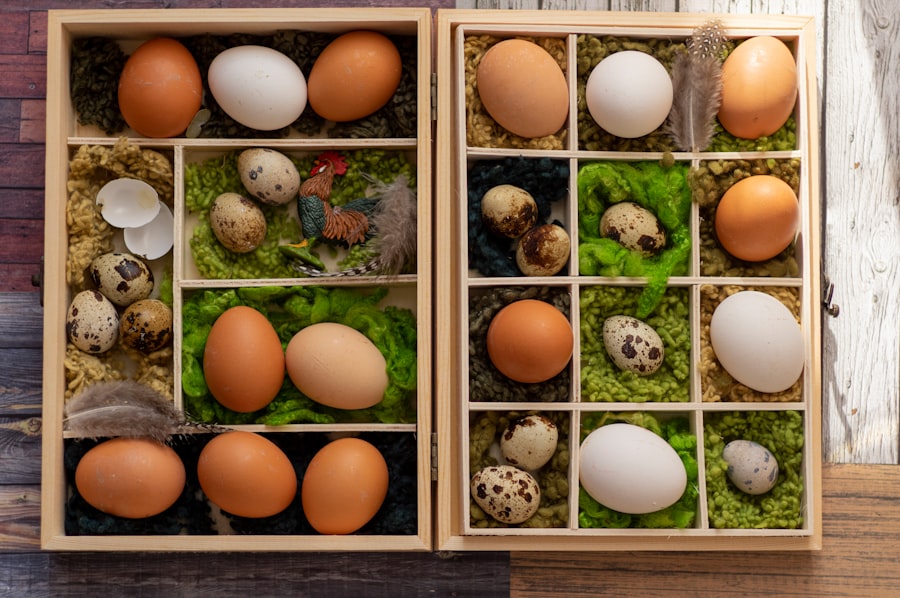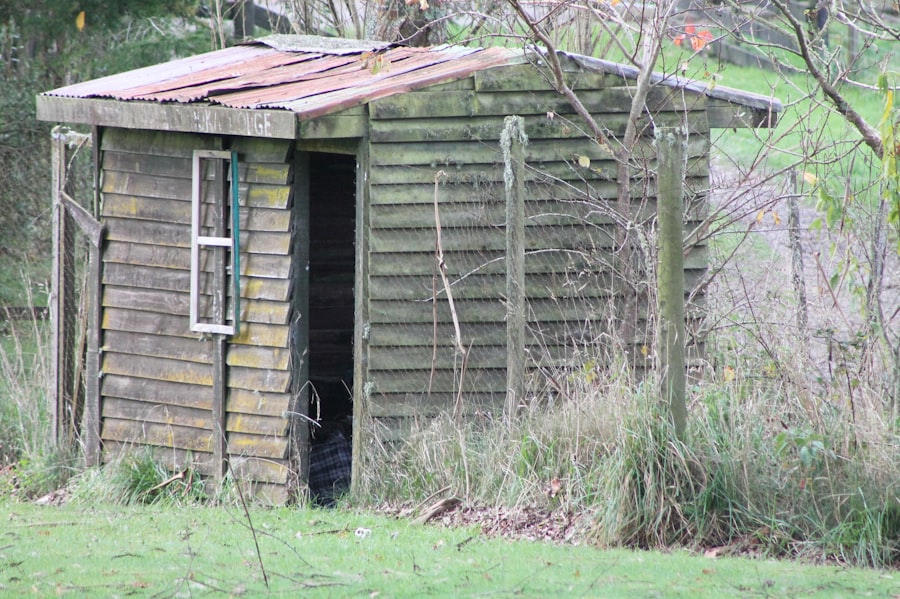Electric fencing for chickens is an effective method of containment and protection. It operates by delivering a mild, non-harmful electric shock to animals that come into contact with it, discouraging them from attempting to breach the fence again. This system can be used to confine chickens to a specific area, guard against predators, and prevent damage to gardens or other parts of the property.
The main components of an electric fence for chickens include:
1. The fence itself, typically made of electrified wire or netting
2. Support posts placed at regular intervals
3.
A charger or energizer that supplies the electric current to the fence
4. Insulators to prevent grounding of the electric current
Electric fences are powered by either batteries or electric outlets. The charger or energizer is connected to the fence and provides the necessary voltage to maintain the electric current.
While electric fencing is an effective solution for chicken owners, it is not infallible. Regular maintenance and monitoring are required to ensure proper functioning. Additionally, chickens need to be trained to respect the fence, and safety precautions should be taken to prevent accidental shocks.
When used correctly, electric fencing can be a valuable tool for maintaining the safety and containment of a chicken flock.
Table of Contents
- 1 Choosing the Right Electric Fence for Your Chicken Coop
- 2 Installing and Maintaining Your Electric Fence
- 3 Training Your Chickens to Respect the Electric Fence
- 4 Safety Considerations for Electric Fencing
- 5 Troubleshooting Common Issues with Electric Fences
- 6 Alternatives to Electric Fencing for Chicken Containment
- 7 FAQs
- 7.1 What is an electric fence for keeping chickens in?
- 7.2 How does an electric fence work to keep chickens in?
- 7.3 Is an electric fence safe for chickens?
- 7.4 What are the benefits of using an electric fence to keep chickens in?
- 7.5 What are the considerations when installing an electric fence for chickens?
Key Takeaways
- Electric fencing provides a safe and effective way to contain chickens and protect them from predators.
- When choosing an electric fence for your chicken coop, consider factors such as voltage, wire type, and power source.
- Proper installation and regular maintenance of the electric fence are essential for its effectiveness and longevity.
- Training your chickens to respect the electric fence involves introducing them to it gradually and using visual and auditory cues.
- Safety considerations for electric fencing include using insulated materials, grounding the fence properly, and keeping it away from water sources.
Choosing the Right Electric Fence for Your Chicken Coop
Size and Layout
The first consideration is the size of your chicken coop and the area you want to enclose. Electric fences come in a variety of lengths and heights, so it is important to choose one that will provide adequate space for your chickens while still keeping them contained.
Predator Protection
Additionally, you will need to consider the type of predators in your area and choose a fence that will be effective at deterring them. For example, if you have a problem with digging predators such as foxes or raccoons, you may want to choose a fence with a buried wire or netting to prevent them from digging under the fence.
Power and Durability
Another important factor to consider when choosing an electric fence for your chicken coop is the power source. Electric fences can be powered by batteries, solar panels, or electric outlets, so it is important to choose a power source that will be reliable and convenient for your specific situation. Additionally, you will need to consider the type of charger or energizer that will be best for your needs, as well as the durability and quality of the materials used in the electric fence. Look for a fence that is made of high-quality materials that will withstand the elements and provide long-term protection for your chickens.
Installing and Maintaining Your Electric Fence

Once you have chosen the right electric fence for your chicken coop, it is important to properly install and maintain it to ensure that it remains effective at keeping your chickens safe and contained. The first step in installing an electric fence is to carefully plan the layout and design of the fence. This includes determining the perimeter of the area you want to enclose, choosing the placement of posts and supports, and ensuring that there are no obstacles or hazards that could interfere with the fence.
It is important to follow the manufacturer’s instructions for installation and use proper safety precautions when working with electric fencing materials. After planning the layout of the fence, the next step is to install the posts and supports. This may involve digging holes for posts, driving posts into the ground, or attaching supports to existing structures.
It is important to ensure that the posts are securely in place and that they are spaced at regular intervals to provide adequate support for the fence. Once the posts are in place, the next step is to install the fence itself. This may involve attaching wire or netting to the posts and insulators, connecting the fence to the charger or energizer, and testing the fence to ensure that it is electrified and working properly.
Once the electric fence is installed, it is important to regularly maintain and monitor it to ensure that it remains effective at keeping your chickens safe and contained. This may involve checking the voltage of the fence regularly, inspecting for any damage or wear, and clearing away any debris or vegetation that could interfere with the fence. Additionally, it is important to regularly check the charger or energizer to ensure that it is functioning properly and providing enough power to keep the fence electrified.
By properly installing and maintaining your electric fence, you can ensure that it remains an effective tool for protecting your chickens.
Training Your Chickens to Respect the Electric Fence
Training your chickens to respect the electric fence is an important step in ensuring their safety and containment. While electric fences are designed to deliver a mild shock that is not harmful to chickens, it is still important to train them to avoid coming into contact with the fence whenever possible. The first step in training your chickens to respect the electric fence is to introduce them to it gradually.
This may involve allowing them to explore the fenced area while closely supervising them and providing positive reinforcement when they avoid coming into contact with the fence. In addition to gradually introducing your chickens to the electric fence, it is also important to provide clear visual cues that will help them understand its boundaries. This may involve using flags or other markers to make the fence more visible, as well as providing physical barriers such as netting or poultry fencing to prevent chickens from accidentally wandering into the electrified area.
It is also important to provide positive reinforcement when chickens avoid coming into contact with the fence, such as providing treats or praise when they stay within the designated area. Another important aspect of training chickens to respect the electric fence is consistency. It is important to consistently reinforce the boundaries of the fenced area and provide clear signals that will help chickens understand where they should and should not go.
This may involve regularly walking the perimeter of the fenced area with your chickens, providing verbal cues or commands, and using physical barriers when necessary. By consistently reinforcing these boundaries, you can help your chickens understand and respect the electric fence.
Safety Considerations for Electric Fencing
While electric fencing can be an effective tool for keeping chickens safe and contained, it is important to take safety considerations into account when using this type of fencing. One of the most important safety considerations for electric fencing is ensuring that it is installed properly and maintained regularly. This includes following manufacturer’s instructions for installation, using proper safety precautions when working with electrified materials, and regularly checking for any damage or wear that could compromise the effectiveness of the fence.
In addition to proper installation and maintenance, it is also important to consider safety precautions for both humans and animals when using electric fencing. This may involve placing warning signs or markers near the fence to alert people and animals of its presence, as well as providing clear visual cues such as flags or markers that will help animals understand its boundaries. It is also important to regularly check the voltage of the fence and ensure that it is delivering a mild shock that is not harmful to animals.
Another important safety consideration for electric fencing is preventing accidental shocks. This may involve using insulators and other materials that will prevent animals from grounding out on the fence, as well as providing physical barriers such as netting or poultry fencing to prevent animals from accidentally coming into contact with electrified areas. By taking these safety considerations into account, you can ensure that your electric fence remains an effective tool for protecting your chickens without posing any unnecessary risks.
Troubleshooting Common Issues with Electric Fences

Low Voltage Issues
One common issue with electric fences is low voltage, which can result in a fence that is not effective at deterring predators or containing chickens. Low voltage may be caused by a variety of factors, including a weak or depleted charger or energizer, damaged wires or insulators, or poor grounding. To troubleshoot low voltage issues, it is important to regularly check the charger or energizer and ensure that it is functioning properly, as well as inspecting all components of the fence for any damage or wear.
Damaged or Worn Components
Another common issue with electric fences is damage or wear that can compromise their effectiveness. This may include broken wires or insulators, loose posts or supports, or damage caused by weather or wildlife. To troubleshoot these issues, it is important to regularly inspect all components of the fence for any signs of damage or wear, as well as promptly repairing any issues that are identified. Additionally, it may be helpful to reinforce weak areas of the fence with additional supports or materials that will help prevent further damage.
Interference from Vegetation or Obstacles
In addition to low voltage and damage issues, another common issue with electric fences is interference from vegetation or other obstacles. This may include overgrown grass or weeds that come into contact with the fence and ground out its electrical current, as well as fallen branches or debris that can damage components of the fence. To troubleshoot these issues, it is important to regularly clear away any vegetation or debris that could interfere with the fence, as well as using physical barriers such as netting or poultry fencing when necessary.
Alternatives to Electric Fencing for Chicken Containment
While electric fencing can be an effective tool for keeping chickens safe and contained, there are also alternative options that may be suitable for some situations. One alternative option for chicken containment is traditional poultry fencing, which consists of wire or netting supported by posts and supports. Poultry fencing can be an effective way to keep chickens contained within a specific area and protect them from predators without using electricity.
Additionally, poultry fencing may be more cost-effective than electric fencing and may require less maintenance. Another alternative option for chicken containment is using physical barriers such as walls or structures that will prevent chickens from wandering into unwanted areas. This may include using garden fencing or other types of barriers that will keep chickens contained within a specific area without using electricity.
While physical barriers may not provide the same level of protection from predators as electric fencing, they can be an effective way to keep chickens contained within a specific area. In addition to traditional poultry fencing and physical barriers, another alternative option for chicken containment is using mobile chicken coops or tractors that can be moved around your property as needed. Mobile chicken coops provide a secure and contained space for chickens while allowing them access to fresh grass and insects.
This can be an effective way to keep chickens safe and contained without using permanent fencing solutions. In conclusion, electric fencing can be an effective tool for keeping chickens safe and contained, but it is important to carefully consider all factors before choosing this option for your chicken coop. By choosing the right type of electric fence for your specific needs, properly installing and maintaining it, training your chickens to respect its boundaries, taking safety considerations into account, troubleshooting common issues, and considering alternative options when necessary, you can ensure that your chickens remain safe and secure on your property.
If you’re looking for tips on how to keep your chickens safe and secure, you might want to check out this article on chicken coop portage. It provides valuable information on how to build a secure coop to keep your chickens safe from predators.
FAQs
What is an electric fence for keeping chickens in?
An electric fence for keeping chickens in is a barrier made of electrified wires or netting that is used to contain chickens within a specific area. The electric shock delivered by the fence serves as a deterrent to keep the chickens from escaping.
How does an electric fence work to keep chickens in?
An electric fence works by delivering a mild electric shock to any animal that comes into contact with it. This shock serves as a deterrent to keep the chickens from attempting to fly over or dig under the fence, thus keeping them contained within the designated area.
Is an electric fence safe for chickens?
When installed and maintained properly, an electric fence is safe for chickens. The electric shock delivered by the fence is mild and designed to startle rather than harm the chickens. It is important to regularly check the fence to ensure it is functioning properly and not delivering excessive shocks.
What are the benefits of using an electric fence to keep chickens in?
Using an electric fence to keep chickens in offers several benefits, including providing a secure and effective containment solution, deterring predators, and minimizing the need for physical barriers such as traditional fences.
What are the considerations when installing an electric fence for chickens?
When installing an electric fence for chickens, it is important to consider the appropriate voltage for deterring chickens without causing harm, the proper grounding of the fence, and the regular maintenance and inspection of the fence to ensure its effectiveness. Additionally, it is important to follow local regulations and guidelines for the installation of electric fences.
Meet Walter, the feathered-friend fanatic of Florida! Nestled in the sunshine state, Walter struts through life with his feathered companions, clucking his way to happiness. With a coop that’s fancier than a five-star hotel, he’s the Don Juan of the chicken world. When he’s not teaching his hens to do the cha-cha, you’ll find him in a heated debate with his prized rooster, Sir Clucks-a-Lot. Walter’s poultry passion is no yolk; he’s the sunny-side-up guy you never knew you needed in your flock of friends!







